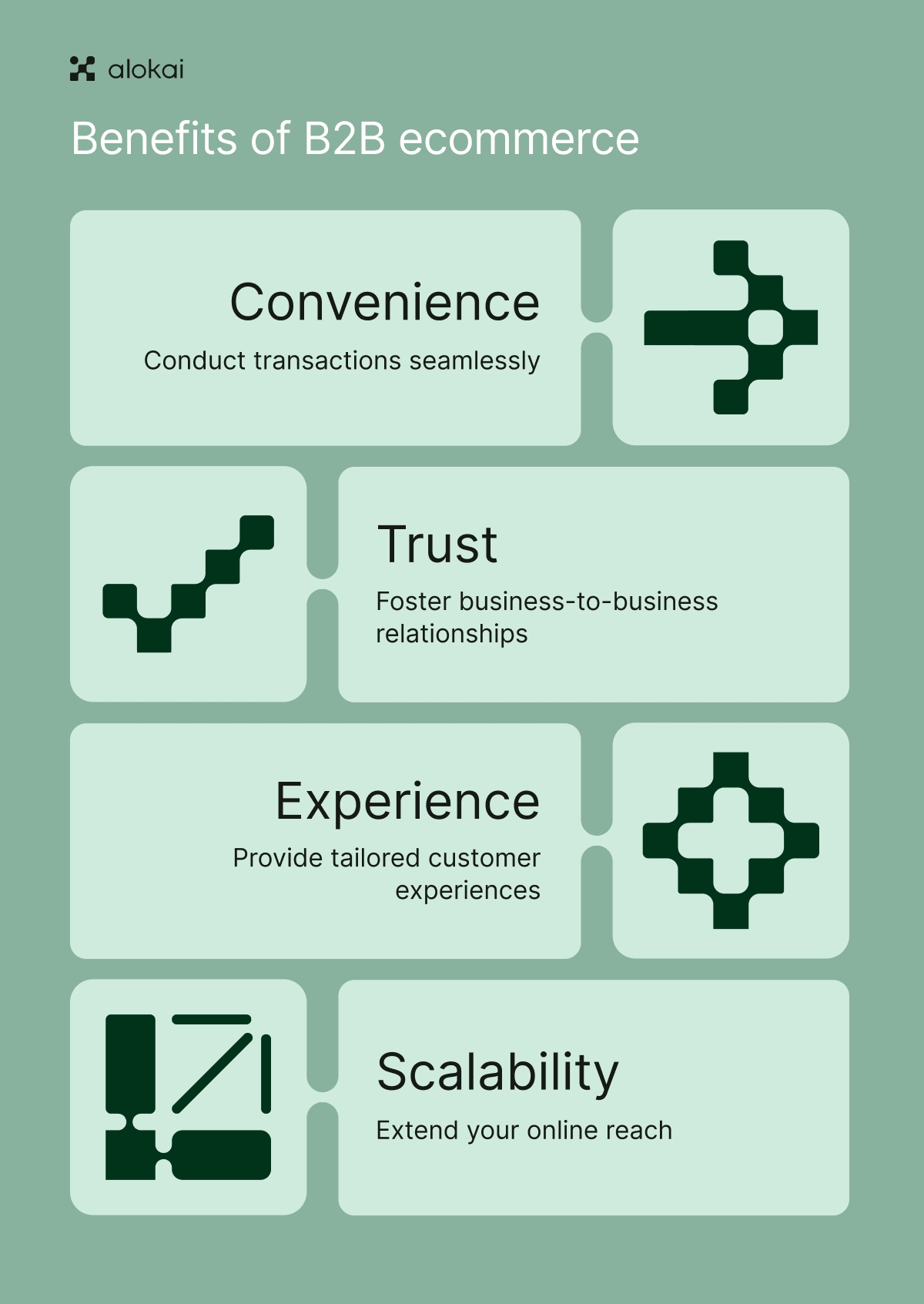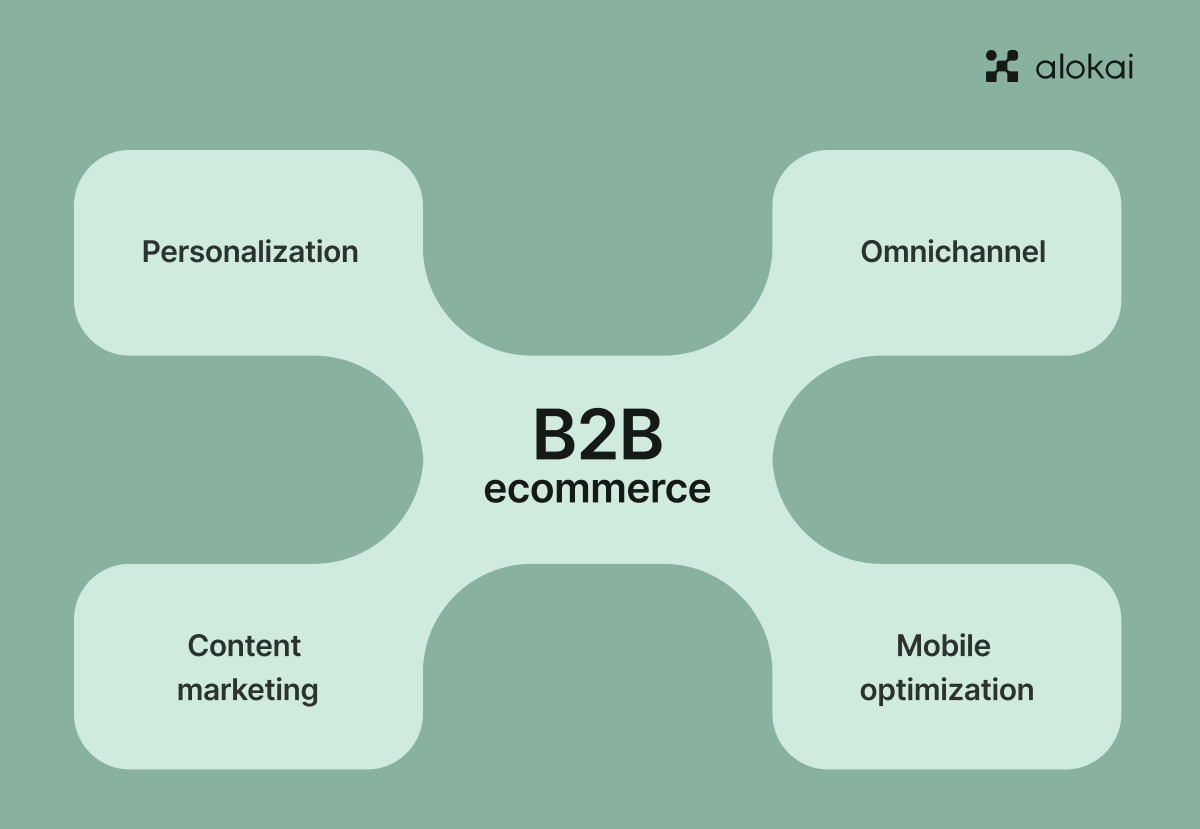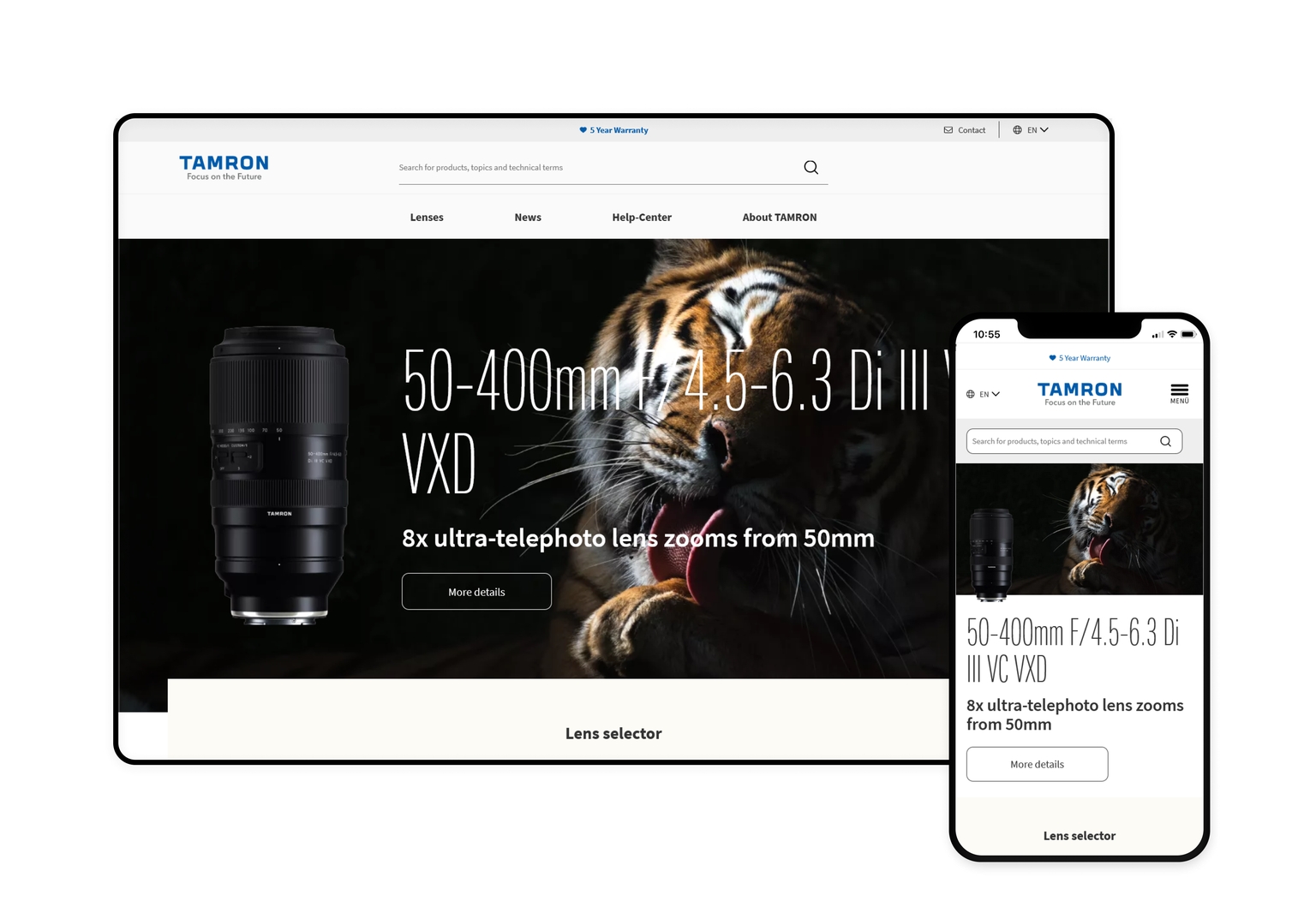If you’re looking for new ways to unlock growth and efficiency in the digital marketplace, B2B ecommerce is your answer. Today's businesses are moving online to survive and thrive, and leveraging ecommerce strategies is proving to streamline operations, boost sales, and enhance customer satisfaction.
This article will guide you through the essential practices for success in B2B ecommerce, helping your business navigate the digital transformation and carve out a competitive edge.
Key takeaways
- B2B ecommerce involves online selling between businesses, enhancing sales processes, and allowing for personalized, efficient transactions.
- Key strategies for success include personalization, omnichannel experiences, content marketing, and mobile optimization.
- Overcoming challenges like complex workflows and data security is essential for success, with technologies like ERP integrations and AI advancements playing a vital role.
What is B2B ecommerce?
Business-to-business ecommerce, referred to as B2B ecommerce, relates to selling products and services online from one business to another, unlike the familiar business-to-consumer (B2C) model, which directs sales to individual consumers.
The online storefront of a B2B ecommerce site serves as an online sales portal, enabling businesses to:
- Conduct transactions seamlessly
- Foster business-to-business relationships
- Provide customized experiences for business clients
- Extend the online reach
In the digital age, an ecommerce website serves dual purposes. It’s not just a conduit for business transactions; it fosters relationships, provides customized experiences for clients, and extends the business’s online reach.

Moreover, B2B ecommerce has given rise to online marketplaces catering to business buyers. These platforms function much like their B2C counterparts but are designed to accommodate wholesale ecommerce. They stand out in handling large-scale business-to-business transactions and catering to the unique needs of business customers.
Understanding B2B ecommerce: Key concepts and definitions
B2B ecommerce is not a buzzword. It forms a vibrant, intricate ecosystem of business-to-business transactions. The stakeholders involved in B2B ecommerce span diverse industries and verticals, each with their unique needs and business models.
The beauty of B2B ecommerce lies in its ability to enhance buying efficiency and open business opportunities to expand its market reach and increase sales. This has proven to be a game-changer for wholesalers, manufacturers, and distributors alike, allowing them to connect with potential customers they may not have been able to reach through traditional sales channels.
For instance, a wholesale ecommerce business may purchase products in bulk from manufacturers and sell them at a markup to other businesses.
The role of technology in B2B Ecommerce
In the current digital age, technology is the backbone of B2B ecommerce. AI, Internet of Things (IoT), and automation are shaking up the B2B ecommerce landscape, driving improvements in efficiency, decision-making, and customer experiences.
For example, integrating B2B ecommerce software with Enterprise Resource Planning (ERP) systems can significantly enhance administrative efficiency. By replacing legacy processes with automated ones, businesses can streamline their operations, enabling them to focus more on strategic tasks.
ERP systems also play an essential role in:
- creating a unified view of a company’s order management, accounting, and customer data;
- preventing data silos;
- promoting real-time business operation insights.
Technology’s influence in B2B ecommerce extends beyond the backend. On the customer-facing side, adaptive search technology, powered by machine learning, is helping B2B buyers find complex products. Personalization engines are also used in B2 B. In general, customer experience is not only the domain of B2C.
Benefits of adopting a B2B ecommerce model
Adopting a B2B ecommerce model offers an array of advantages to businesses, including:
- Streamlining sales processes and reducing manual work;
- Increasing efficiency in transactions and customer interactions;
- Boosting productivity and profitability.
Moreover, businesses can reach a larger audience and expand into new, global markets by utilizing B2B ecommerce platforms.
Adjusting buyers' rising preference for online purchasing can lead to significant cost savings by reducing the need for physical storefronts, diminishing staffing requirements, and streamlining customer service functions.
Additionally, B2B ecommerce enhances customer satisfaction by automating fulfillment and inventory management, facilitating faster deliveries, and building positive customer relations.
Essential B2B ecommerce strategies
Successful B2B ecommerce requires businesses to enact a mix of diverse strategies. These include:
- Personalizing the online shopping experience for business customers;
- Implementing an omnichannel commerce;
- Leveraging content marketing tactics;
- Ensuring mobile optimization.

Personalization in B2B ecommerce hinges on:
- Customizing the customer experience using insights derived from customer data and effective customer relationship management
- Enhancing the online shopping experience
- Leading to improved customer loyalty
- Potential increases in revenue
On the other hand, an omnichannel approach is about ensuring a seamless and consistent customer experience across multiple channels. This is particularly crucial in B2B ecommerce, where customers often interact with suppliers through various channels, from ecommerce sites to social media platforms and even physical stores.
Content marketing is another key strategy that can drive B2B ecommerce success. By creating and sharing valuable, targeted content, businesses can educate their customers, nurture leads, and incentivize purchases through effective marketing strategies.
Finally, with the increasing use of mobile devices for research and purchasing, mobile optimization has become a must-have for B2B ecommerce businesses. This involves ensuring that your ecommerce site is fully accessible and user-friendly on mobile devices, providing a seamless shopping experience for customers on the go.
Personalization
In the world of B2B ecommerce, personalization is king. Today’s business buyers expect a personalized customer experience that mirrors the one they enjoy as individual consumers. This means that B2B sellers must focus on meeting customer expectations by delivering:
- Personalized content;
- Product recommendations;
- An easy-to-use interface;
- Customer-specific catalogs that show relevant items and prices.
Thanks to advancements in machine learning technologies, the capacity for delivering personalization in B2B ecommerce has greatly enhanced. These technologies allow businesses to utilize customer data to tailor their messaging and enhance their offerings.
When implemented effectively, personalization can lead to increased customer loyalty and potentially significant increases in revenue.
Omnichannel approach
The omnichannel approach is just as crucial in B2B ecommerce as it is in B2C sales. Today’s business customers often interact with suppliers through multiple channels, including:
- Company websites;
- Online marketplaces;
- Social media platforms;
- Physical stores.
Therefore, ensuring consistency and seamlessness across online and offline platforms is crucial.
More than just a marketing strategy, an omnichannel approach is about meeting customers where they are and providing a unified, integrated customer experience across all touchpoints.
Investments in technology are key to creating and maintaining seamless service experiences for B2B customers across various channels.
Content marketing
Content marketing is a crucial driver for success in B2B ecommerce. By creating informational, educational, and persuasive content tailored for different stages of the customer journey, businesses can effectively engage customers and guide them toward a high-intent purchase.
Whether it’s a blog post explaining a product's features, a video demonstrating its use, or a case study showcasing its benefits, content marketing attracts and engages the target audience, improves SEO, and ultimately drives online purchases.
Moreover, a solid keyword strategy can increase a site’s ranking on search engines through search engine optimization, attracting more organic traffic and potential customers.
Mobile optimization
This one deserves a separate point. Given the considerable upsurge in mobile usage among B2B buyers, mobile optimization is now indispensable for B2B ecommerce businesses. This means ensuring that your ecommerce site provides a seamless and user-friendly experience on mobile devices.
A mobile-first approach prioritizes the needs of mobile users, ensuring that they can easily navigate your site, find the products they need, and complete purchases. Implementing a mobile-first strategy can lead to improved user experience, increased customer satisfaction, and, ultimately, higher sales.
Overcoming common B2B ecommerce challenges
As with any business model, B2B ecommerce presents its unique challenges. Some of these challenges include:
- Offering flexible payment options;
- Managing complex purchasing workflows;
- Ensuring data security;
- Maintaining stocking transparency.
One of the common challenges in B2B ecommerce is the need for flexible payment options. Offering flexible payment terms through B2B credit solutions can build customer loyalty and manage financial risks. Additionally, integrating composable commerce into your B2B tech stack can make it more convenient for your customers to pay how they prefer.
Another challenge is the increasing preference of B2B customer groups, including existing customers, for self-service buying options. This shift modifies the traditional role of sales reps, requiring businesses to adapt their sales process and strategies accordingly.
Managing B2B purchasing workflows with multiple stakeholders is another challenge that requires robust back-office management and integrated tools such as:
- CRM systems;
- ERP systems;
- Procurement platforms;
- Ecommerce platforms;
- Supply chain management solutions.
These tools can improve efficiency and spending control.
Finally, establishing stringent security procedures and software is essential to safeguard customer data and the digital infrastructure of B2B ecommerce platforms.
Composable commerce in B2B
Composable commerce offers a flexible and adaptable solution for B2B ecommerce. It allows businesses to seamlessly integrate with existing systems, enabling them to be more agile in managing multiple frontend applications while maintaining a unified backend.
If your business requires customizability, which is often the case in B2B scenarios, composable commerce can provide the flexibility you need to design customer journeys and choose the technology that fits best.
B2B ecommerce Success Stories
Now that we’ve covered the essentials of B2B ecommerce, let’s take a look at some real-world success stories. These stories illustrate how businesses have effectively implemented B2B ecommerce strategies, offering insights and inspiration for others looking to embark on their own B2B ecommerce journey.
Zenni Optical

First up is Zenni Optical, a pioneer in the online eyewear business. Zenni Optical expanded its business model by engaging with health insurance companies offering their patients vision coverage. This approach required launching a completely new B2B experience on a tight schedule, which they achieved using Alokai Cloud. The results were impressive, with a 75% improvement in average page load speed and a 16% increase in site traffic within the first four weeks of the site going live.
SKYdeals

Next is SKYdeals, an innovative company that transformed traditional inflight shopping into an exhilarating shoppertainment experience. By partnering with Alokai, SKYdeals launched four in-flight stores and achieved a 60% boost in homepage load speed, right out of the gate.
Tamron Europe

Tamron Europe, a leader in the optical industry, identified an opportunity to reduce the distance between the company as a manufacturer and the consumers. They trusted the project with the Webmatch team, which did a great job regarding choosing the tech stack and the development itself. While the project is still in progress, the promising results of using Alokai Frontend as a Service were evident from day one.
Tips for choosing the right B2B ecommerce platform
Selecting the appropriate B2B ecommerce platform is a critical decision with a substantial impact on your business’s success. Here are some tips to guide you in making the right choice.
Firstly, consider the platform's scalability. As your business grows, you will need a platform that can handle increased business demands, allowing new products, customers, and sales channels to be added.
Flexibility is also a key feature to look for. A flexible platform will enable you to add new functions and entities easily, while a customizable platform ensures that you can tailor features to your specific needs.
Finally, consider whether the platform offers an API-first approach, a composable architecture, and open-source options. These features will offer flexibility, efficient integration with external systems, and greater control over features.
You might be interested in our guide about headless commerce platforms.
Future trends in B2B ecommerce
Looking forward, we anticipate several trends that will mold the future landscape of B2B ecommerce. From increased digital transactions to emerging business models and advancements in AI, the future of B2B ecommerce looks bright.
Gartner reports that by 2025, it’s predicted that 80% of B2B sales transactions between buyers and suppliers will take place through digital channels. Moreover, Forester predicts that by 2027, US B2B ecommerce sales will reach $3 trillion for 24% of all US B2B sales. These trends reflect the growing importance of digital channels in facilitating business transactions.
Emerging business models such as B2B2C, D2C, and B2B marketplaces provide new avenues for B2B enterprises to engage in ecommerce. Meanwhile, AI is expected to significantly increase revenue by changing how digital commerce is perceived.
Another trend to watch out for is the growing need for API-first integrations. These offer flexibility and efficient integration of diverse systems, which are expected to improve customer experience and increase security.
Lastly, data orchestration is becoming increasingly important in delivering personalized customer experiences by collecting, aggregating, and analyzing customer data from various sources.
Summary
B2B ecommerce presents many opportunities for businesses willing to embrace digital transformation. From streamlining sales processes and expanding market reach to enhancing customer satisfaction and driving revenue growth, the benefits of B2B ecommerce are clear.
However, success in B2B ecommerce requires a strategic approach, employing key strategies such as personalization, omnichannel marketing, content marketing, and mobile optimization. As we look ahead, businesses must stay abreast of emerging trends and leverage technology to stay competitive in the evolving B2B ecommerce landscape. So, are you ready to maximize your business with B2B ecommerce?













